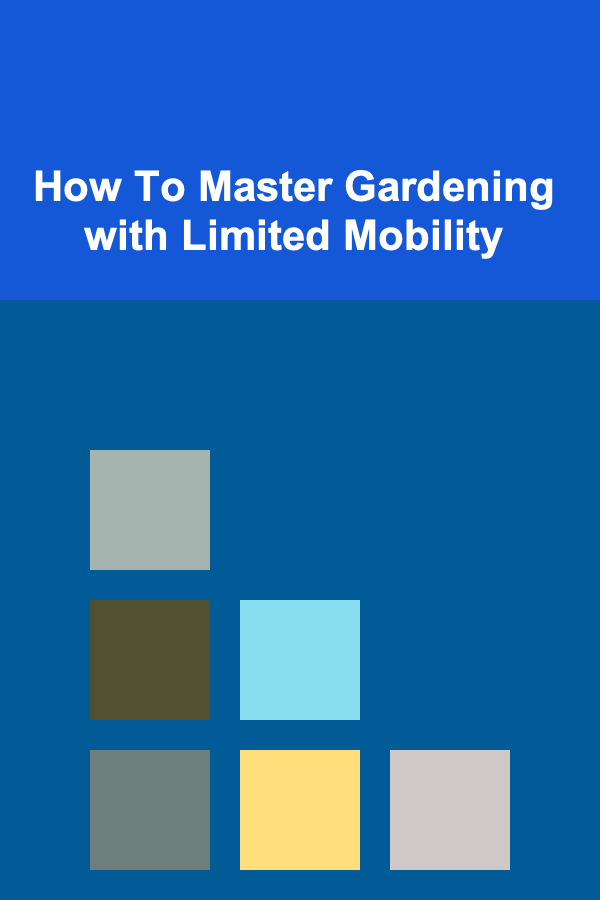
How To Master Gardening with Limited Mobility
ebook include PDF & Audio bundle (Micro Guide)
$12.99$7.99
Limited Time Offer! Order within the next:

Gardening is an incredibly rewarding hobby that offers a range of benefits, from the satisfaction of growing your own food to the calming effects of being immersed in nature. For individuals with limited mobility, gardening might seem like a challenging activity. However, with the right strategies, tools, and mindset, anyone can enjoy the therapeutic and fruitful world of gardening. This guide will explore how to adapt gardening techniques and approaches for those with physical limitations, ensuring that gardening remains an enjoyable and accessible pursuit.
Understanding the Challenges of Gardening with Limited Mobility
Limited mobility can take many forms, whether due to age, injury, illness, or physical disabilities. The challenges that come with restricted movement include difficulty bending, kneeling, reaching, and walking. These limitations may make traditional gardening tasks, such as weeding, planting, and watering, seem arduous or even impossible.
However, gardening is highly adaptable, and by considering both physical and environmental adjustments, individuals with limited mobility can continue to cultivate beautiful, thriving gardens. Overcoming these barriers starts with an understanding of the specific needs of the gardener and the willingness to make thoughtful modifications.
Choosing the Right Garden Design
One of the most crucial steps in mastering gardening with limited mobility is selecting a garden design that minimizes physical strain. The design will play a significant role in your ability to reach plants, care for them, and move around the space comfortably.
Raised Beds
Raised garden beds are ideal for individuals with limited mobility because they allow for gardening at a more comfortable height. These beds can be built at waist or chest height, reducing the need to bend over or kneel while tending to plants. Raised beds can be constructed using a variety of materials such as wood, stone, or metal. Additionally, they can be placed at a height that suits your needs, ensuring ease of access.
Raised beds also offer better soil drainage and can be filled with high-quality soil, which improves plant growth. If you are unable to bend down, adding long, narrow raised beds in a U-shape or with accessible paths between them will make it easier to reach every part of your garden.
Container Gardens
Container gardening is another versatile option. By growing plants in pots, containers, or other movable vessels, you can position them at a height or location that works best for you. Containers come in various sizes and shapes, which means they can fit into small spaces or be elevated on platforms, tables, or even hanging baskets.
Using containers also allows for better control over soil quality and moisture levels. If bending down is a challenge, consider placing containers on elevated stands, or use plant carts with wheels for easy mobility.
Vertical Gardens
For gardeners who have difficulty with horizontal space, vertical gardening can be an excellent alternative. Vertical gardens involve growing plants on structures such as trellises, towers, or wall-mounted planters. This approach makes it possible to grow a variety of plants without requiring much bending or kneeling.
Climbing plants like beans, cucumbers, and tomatoes thrive in vertical gardens, while flowers, herbs, and even strawberries can also be grown on vertical racks or hanging baskets. Vertical gardens also maximize space, making them a great choice for those with limited area or mobility.
Using the Right Tools and Equipment
Garden tools play a critical role in ensuring that gardening remains manageable for individuals with limited mobility. The right tools can significantly reduce strain on the body and allow for easier handling of tasks.
Ergonomic Tools
Ergonomically designed tools are specially crafted to reduce physical strain and improve comfort. For example, garden tools with padded handles and adjustable angles can help prevent wrist, hand, or arm fatigue. Look for tools with lightweight construction, as heavy tools can cause unnecessary strain, particularly on joints and muscles.
Ergonomic trowels, hoes, and weeders are designed with comfortable grips and angles that reduce the need to bend or twist. There are even gardening gloves designed for better grip and comfort, which can help prevent blisters or hand fatigue during longer gardening sessions.
Long-Handled Tools
Long-handled tools such as hoes, rakes, and shovels can be extremely helpful for individuals with limited mobility. These tools allow gardeners to reach plants and soil without bending over, kneeling, or squatting. Many of these tools are designed with adjustable handles to accommodate different heights, making it easier for users to maintain a comfortable posture while gardening.
For those with limited grip strength, there are also tools with large, easy-to-hold handles that make gripping the tool easier. These tools can help ensure that individuals can garden with greater comfort and fewer physical limitations.
Mobility Aids for the Garden
For those who have difficulty moving around their garden, mobility aids such as rollators, wheelchairs, or scooters can make it easier to get from one section of the garden to another. These aids are especially useful for individuals with limited walking ability or those who need additional support for balance.
Some gardeners may benefit from creating designated garden paths that accommodate mobility aids. Smooth, wide paths made from materials like gravel, mulch, or wood chips can help ensure safe and easy access to different areas of the garden.
Planning for Accessibility
Accessibility is key to creating a garden that anyone with limited mobility can navigate comfortably. In addition to garden design, careful planning of your garden layout will help minimize physical strain and ensure that you can reach and tend to your plants with ease.
Wide Paths and Clear Navigation
Ensure that paths between garden beds, containers, and other features are wide enough to accommodate mobility aids such as wheelchairs or walkers. A path width of at least 36 inches is recommended to provide adequate space for movement.
Paths should be smooth and free from obstacles like uneven ground or trip hazards. Gravel, bricks, or paving stones can create solid, easy-to-navigate pathways that are comfortable for wheelchairs or walkers. It's important to plan pathways to connect different parts of the garden, allowing easy access to every plant without the need for long walks or heavy lifting.
Easy Access to Tools and Supplies
A well-organized garden shed or storage area can make it easier to access tools and gardening supplies without excessive bending or reaching. Consider placing your tools on a raised table or wall-mounted pegboard, and ensure that supplies like fertilizers, watering cans, and gloves are stored within easy reach.
Using Garden Benches or Kneeling Pads
For those who do need to sit or kneel occasionally, incorporating garden benches or kneeling pads can offer added comfort. Kneeling pads, which provide cushioned support, can make it easier for gardeners to work at a lower height. If kneeling is difficult, a garden bench can provide a comfortable place to sit and work, particularly for tasks like pruning, deadheading, or weeding.
Adapted Gardening Techniques
In addition to modifying the garden design and using the right tools, adapting gardening techniques can help individuals with limited mobility achieve their gardening goals.
No-Dig Gardening
No-dig gardening is a method that minimizes physical labor by eliminating the need to dig up the soil. Instead, layers of organic materials such as compost, mulch, and cardboard are used to enrich the soil and control weeds. This technique reduces the need for heavy lifting and soil disruption, making it an excellent option for gardeners with limited mobility.
Mulching for Weeding and Moisture Retention
Mulch plays a vital role in reducing the need for frequent weeding and watering. A thick layer of mulch around plants can help suppress weeds, maintain soil moisture, and keep the roots cool. This minimizes the need for manual weeding and watering tasks, both of which can be physically taxing.
Hydroponics and Aquaponics
For those with limited mobility, hydroponics (growing plants in water without soil) and aquaponics (a system that combines fish farming with hydroponics) can offer a highly efficient way to grow food with minimal physical effort. These methods are often used in vertical gardening systems and can be set up in elevated beds or containers, reducing the need to bend down or kneel.
Hydroponic and aquaponic systems can be automated to reduce the amount of maintenance required. For example, automated watering systems or self-sustaining aquaponic setups can reduce the need for manual labor, allowing you to enjoy gardening without the physical strain.
Engaging in Gardening Activities with a Support System
If gardening becomes physically challenging, it can help to have a support system to assist with tasks that are particularly difficult. Family members, friends, or caregivers can assist with physically demanding tasks, such as heavy lifting, digging, or moving large plants. Involving others in the gardening process also fosters a sense of community and shared enjoyment.
For example, a support person can help prepare the soil or plant the larger items, while the gardener focuses on smaller tasks such as watering, trimming, or harvesting. This division of labor ensures that you are still able to participate in the joy of gardening, without overexerting yourself.
Conclusion
Gardening with limited mobility is not only possible---it can be deeply fulfilling. By embracing adaptive techniques, tools, and garden designs, individuals with mobility challenges can continue to enjoy the physical and emotional benefits of gardening. Whether through raised beds, container gardens, or vertical farming, there are countless ways to adapt gardening to suit your needs. With the right strategies in place, anyone can transform their space into a beautiful and productive garden, regardless of physical limitations.
Mastering gardening with limited mobility requires planning, patience, and a willingness to make thoughtful adjustments. With persistence, you can unlock the joys of gardening and create a thriving, accessible garden that is both fulfilling and restorative.
Reading More From Our Other Websites
- [Home Rental Property 101] How to Set Up a Property Management System for Your Rental Property
- [Home Storage Solution 101] How to Make the Most of Your Closet with Adjustable Shelving
- [Personal Finance Management 101] How to Build Wealth Even When You Have a Low Income
- [Home Space Saving 101] How to Create a Compact Mudroom Solution
- [Home Budget Decorating 101] How to Use Fabric and Textiles to Update Your Home on a Budget
- [Organization Tip 101] Basement Waterproofing: Is Interior or Exterior Waterproofing Better?
- [Home Storage Solution 101] How to Store Bedding and Linens in a Neat and Accessible Way
- [Home Soundproofing 101] How to Reduce Traffic Noise Inside Your Home
- [Home Budget Decorating 101] How to Decorate Your Home with Functional Yet Affordable Storage Solutions
- [Home Cleaning 101] How to Clean Grout Without Harsh Chemicals

How to Budget for a Home Renovation Project and Stay on Track
Read More
How to Clean Your Home When You Have Small Kids
Read More
How to Renovate Your Home for a Family-Friendly Layout
Read More
Team Dynamics: Building Strong, Collaborative Workforces in Factories
Read More
Choosing the Best Portable Power Bank for Camping
Read More
10 Tips for Incorporating Mindfulness into Your Parenting Planner
Read MoreOther Products

How to Budget for a Home Renovation Project and Stay on Track
Read More
How to Clean Your Home When You Have Small Kids
Read More
How to Renovate Your Home for a Family-Friendly Layout
Read More
Team Dynamics: Building Strong, Collaborative Workforces in Factories
Read More
Choosing the Best Portable Power Bank for Camping
Read More